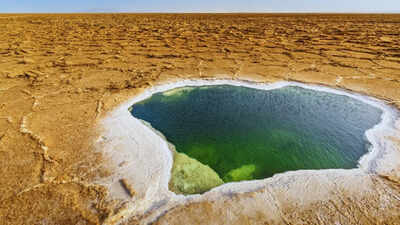ARTICLE AD BOX

In the scorching, otherworldly landscape of Ethiopia’s Danakil Depression lies Gaet’ale Pond, a small body of water that holds the prestigious title of the world’s saltiest lake, as recognised by the Guinness World Records.
The lake’s salt concentration is a staggering 43.3 percent by weight. If you thought the Dead Sea and Antarctica’s Don Juan Pond were salty, Gaet’ale surpasses these hypersaline lakes effortlessly. According to the Guinness World Records, Gaet’ale Pond, located in the Afar Region of Ethiopia, was confirmed as the most saline water body on Earth. The pond’s salinity was measured at 43.3 percent, significantly higher than Don Juan Pond’s 40.2 percent and the Dead Sea’s 23.1 percent.
Here’s something to understand this better: So far we used to think that the sea water is too salty. Well, the average salinity of sea and ocean water is just 3.38 percent.
The extreme concentration of Gaet’ale Pond water is primarily composed of magnesium chloride and calcium chloride. Needless to say, the water of Gaet’ale is inhospitable to most life forms.

Everything about Gaet’ale Pond is mesmerising. For instance, Gaet’ale Pond is situated in the Danakil Depression, one of the hottest and lowest places on Earth, sitting 120 meters below sea level.
The landscape will make you feel like you are on some alien planet. For as far as the eyes can see, there are salt flats in all shapes and sizes. Salt flats, volcanic craters, hydrothermal springs dot the region. If that’s not shocking enough for the senses, wait till you get a whiff of the sulphur in the air.
And this is immediate. The entire area has an overwhelming smell of sulphur, which will most definitely remind you of rotten eggs.
The heat is something else too. Gaet’ale Pond is one of several small water bodies near the Dallol Spring, formed over a hot spring with no inlet or outlet streams, leading to intense evaporation and salt accumulation. Gaet’ale may be big on salt content, but it is modest in size, covering just 0.03 sq km. Virtually nonexistent rain is one of the main reasons for its small surface area. While the pond is absolutely inhospitable for fishes and other life forms, microbes such as halophiles can not only survive here, they create a unique ecosystem too.
But one that works only for them. Also, Gaet’ale is too remote and extreme for recreational use.



.png)
.png)
.png)
















 3 hours ago
4
3 hours ago
4







 English (US) ·
English (US) ·